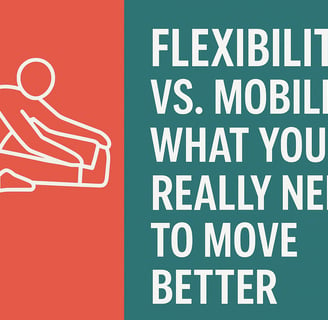Flexibility vs. Mobility: The One Concept You’re Probably Getting Wrong (And How to Fix It)
Most people stretch and still feel tight. Here’s why: flexibility isn’t the same as mobility—and training one without the other is holding your body back. Learn the real difference, plus drills and tools that unlock better movement, injury prevention, and lasting results.
5/22/20253 min read


Flexibility vs. Mobility: What You Really Need to Move Better
The Difference That Matters
Flexibility is your ability to passively elongate a muscle—think toe touches or calf stretches.
Mobility means actively controlling movement through a joint’s full range—like squatting while keeping your spine upright.
Good flexibility is useful, but without control (mobility), it’s hard to apply that range in real life—like deadlifting with loose hamstrings but no core or hip engagement. That combination sets you up for injury. Let’s explore practical drills and three key tools to support progress.
1. Flexibility Made Simple
Drill: Static Hamstring Stretch
Sit with one leg extended, hinge at the hips, reach toward your toes, and hold for 30 seconds. Switch sides.
Why it works: Lengthens muscle fibers and improves passive range—ideal for cool-downs or pre-run prep.
2. Mobility You Can Use
Drill: Goblet Squat to Box
Hold a light kettlebell or dumbbell at your chest, squat to a box just below parallel, and stand while keeping your chest upright and knees tracking forward.
Why it matters: Teaches you to use flexibility by loading the hips and ankles with control.
3. Combo Drill: Hip Hinge + Control
Drill: Active Hamstring Hinge
Stand upright, shift hips backward with a slight knee bend (like a bow), keep a neutral spine, reach toward mid-shin, then return.
Why it helps: Builds active control through the stretch—no rounding allowed.
Product We Recommend: Tiger Tail The Stick - 18" Self Myofascial Roller
Why it stands out:
This manual muscle roller provides deep-tissue release with a firm but cushioned design. It targets sore muscles effectively and simplifies pre/post-mobility routine Amazon.
How to use:
Roll calves, quads, hamstrings, and back for 60 seconds each.
Pause on tight spots for 20 seconds for a targeted release.
Follow with dynamic drills to reinforce new range.
Best for:
Athletes and desk workers who want a portable, travel-friendly tool to prep for movement or recover faster.
4. Shoulder Control Over Stretch
Drill: Wall Slides
Stand with back against a wall, elbows bent 90°. Slide arms overhead while maintaining contact with the wall, then lower back with control.
Why it works: Builds strength in the rotator cuff and upper back—turning passive stretch into useful reach and stability.
5. Linking Movement: Ankle + Hip
Sequence:
Ankle Rock Stretch (kneel facing wall, rock forward)
Active Hamstring Hinge (above)
Goblet Squat to Box
Why it works:
Combines flexibility with control across joints—making sure loosened tissues are actively usable in movements like squats and lunges.
Product We Recommend: Insonder Mini Resistance Bands
Why it helps:
These lightweight therapy bands (10–40 lb tension) are ideal for adding load to mobility drills—especially for hip and shoulder stability Amazon.
How to use:
Band side walks or monster walks to train hip control
Add light resistance to wall slides to strengthen scapular muscles
Build active control by combining glute and shoulder activation
Best for:
Anyone wanting portable resistance to progress beyond passive stretching.
6. Pitfalls: Don’t Just Stretch and Stop
A common mistake is static stretching then jumping straight into heavy activity. Instead, follow this flow:
Use the muscle roller stick
Do active drills (hinge + squat)
Load the movements with control
That sequence turns loosened tissues into usable performance assets.
7. Trigger-Point Recovery
Drill: Use a massage or lacrosse ball on tight spots—like glutes or upper back. Lean into a wall and hold pressure for 20–30 seconds, then follow up with a mobility exercise in that range.
Product We Recommend: RAD Rounds Myofascial Release Balls
Why it helps:
These silicone balls are perfect for pinpoint pressure without diving too deep. Grip-friendly and precise for targeted relief Amazon.
How to use:
Lean into the ball on tight areas using a wall or floor
Hold for 20–30 seconds, then move through a mobility repetition like a hinge or wall slide
Best for:
Anyone wanting efficient release before or after active mobility work.
Sample Daily Flow (≈10 Minutes)
Warm-Up (2 min): Use Tiger Tail on calf/quads
Dynamic Activation (2 min): Ankle rocks + active hinge
Controlled Mobility (3–4 min): Goblet squats + wall slides
Targeted Release (2 min): RAD Rounds on tight spots + depth reinforcement
Why It Works
Flexibility gives you potential range.
Mobility teaches you how to use it with strength and control.
Tools like muscle rollers, resistance bands, and release balls bridge passive flexibility to functional movement.
Over time, this builds better control, stability, and reduces injury risk—on the field, court, or in everyday life.
FITNESS
Nutrition
WellnesS
info@movebetterco.com
© 2025. All rights reserved | Privacy Policy | Terms & Conditions